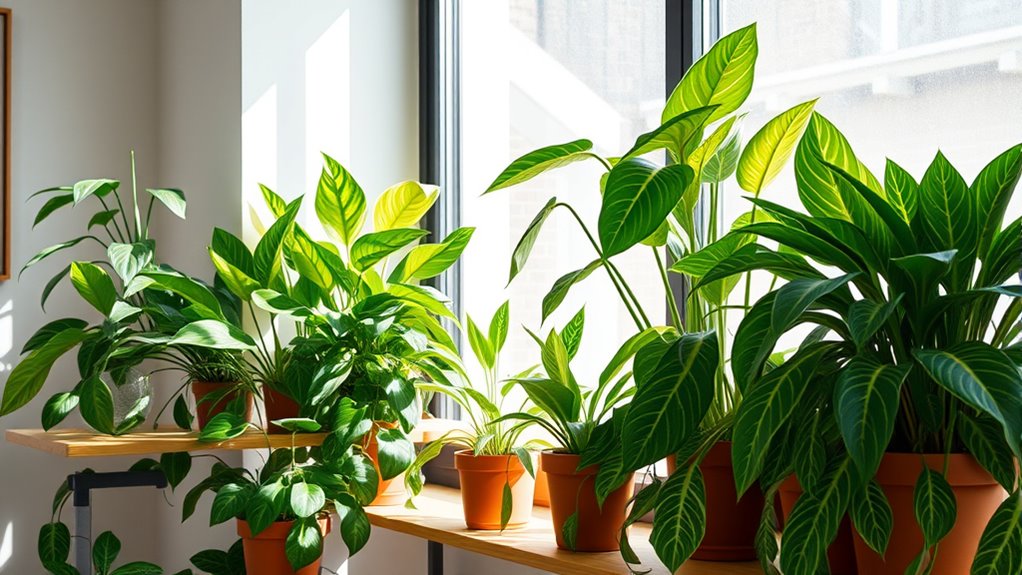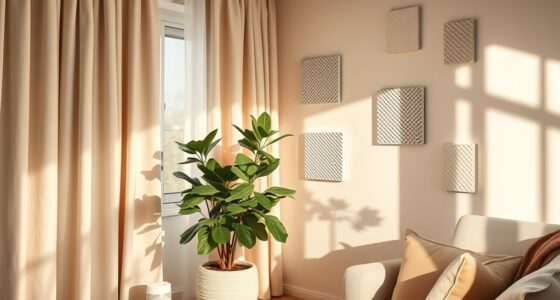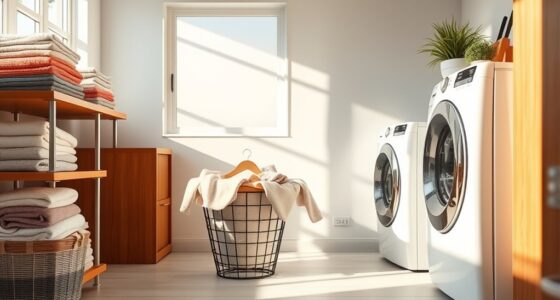While houseplants can help reduce certain airborne toxins, their air-purifying claims are often exaggerated, and they shouldn’t replace good ventilation or cleaning routines. They do contribute to better indoor air quality, but their effectiveness depends on the type and number of plants you have. Proper plant care and choosing non-toxic varieties are also important. Want to discover how to get the most benefits from your plants and keep your home healthy? Keep exploring for more insights.
Key Takeaways
- Houseplants can reduce some indoor pollutants but are not a complete solution; proper ventilation is essential.
- Many claims about air purification are exaggerated; plants should complement other air quality measures.
- Healthy, well-cared-for plants perform better at filtering airborne toxins.
- Some popular air-purifying plants are toxic to pets and children; choose non-toxic varieties or keep them out of reach.
- The effectiveness of houseplants depends on quantity and environment; they are helpful but not a substitute for good hygiene and pollution reduction.

Houseplants do more than brighten up your space—they actively improve your indoor air quality. When you consider adding plants to your home, it’s natural to wonder about their ability to purify the air and whether certain plants are better suited for this purpose. However, it’s important to approach this with realistic expectations. Many claims about air-purifying houseplants are based on studies that often used large quantities of plants in controlled environments, not typical home settings. So, while certain plants can help reduce some airborne toxins, they shouldn’t replace proper ventilation or cleaning routines.
Getting into plant care is essential if you want your houseplants to perform their best. Healthy plants are better at filtering pollutants, so you need to provide the right amount of light, water, and nutrients. Avoid overwatering, which can lead to root rot, and ensure your plants aren’t exposed to drafts or extreme temperatures. Regularly dusting the leaves helps maximize their ability to absorb air pollutants. Remember, some common houseplants marketed as air purifiers are toxic plants if ingested, especially if you have pets or small children. Research thoroughly before bringing a new plant into your home, particularly if you’re concerned about toxins. Many popular options, like some types of philodendrons, dieffenbachias, or peace lilies, are beautiful but can pose health risks if chewed or ingested. If you have animals or kids who might get curious, opt for non-toxic plants or keep toxic plants out of reach.
While plants like snake plants, pothos, and spider plants are often praised for their air-cleaning properties, it’s worth noting that they won’t eliminate all pollutants entirely. They can contribute to better indoor air quality, but they’re just one piece of the puzzle. Proper ventilation, reducing sources of indoor pollution, and maintaining good hygiene are equally important. Don’t rely solely on plants to do the work; they’re an excellent complement but not a magic solution. Additionally, understanding the contrast ratio of your plants’ leaves can help you choose varieties that maximize light absorption and pollution filtering.
Frequently Asked Questions
Do All Houseplants Improve Indoor Air Quality Equally?
Not all houseplants improve indoor air quality equally. Your plant diversity impacts how well your space circulates and cleans the air. Some plants, like spider plants or snake plants, are more effective because they filter toxins better. Good air circulation helps these plants work more efficiently. So, selecting a variety of plants and ensuring proper airflow will maximize their air-purifying benefits and create a healthier indoor environment.
Can Air-Purifying Plants Eliminate All Indoor Pollutants?
Imagine trying to sweep away a flood with a broom—that’s how effective air-purifying plants are against all indoor pollutants. While they help with pollutant removal and improve air quality, their plant efficacy isn’t enough to eliminate every contaminant. You won’t find a single plant that can completely clear your indoor air, but adding a variety boosts overall pollutant removal and creates healthier space.
How Much Light Do Air-Purifying Plants Need Daily?
You wonder how much light your air-purifying plants need daily. Generally, they thrive with natural light for about 4-6 hours a day, but they can also adjust to artificial illumination if natural light isn’t enough. Place them near a window with indirect sunlight, or use grow lights to guarantee they get the right amount of light. Consistent lighting helps them stay healthy and effectively purify your indoor air.
Are Air-Purifying Plants Safe for Pets and Children?
Think of your home as a garden of trust. Toxicity concerns mean you should be cautious, as some air-purifying plants can be harmful to pets and children. While many are safe, others pose risks. You can choose pet-safe alternatives like spider plants or Boston ferns, which purify air without danger. Always research or consult a vet or expert to guarantee your green companions are safe for everyone in your home.
How Often Should I Water My Air-Purifying Houseplants?
You should water your air-purifying houseplants based on their specific needs, but generally, watering frequency depends on the plant and environment. Most plants prefer their soil to dry out slightly between waterings. To get your plant care routines right, check the top inch of soil; if it feels dry, it’s time to water. Avoid overwatering, which can harm your plants, and adjust as seasons change.
Conclusion
While houseplants can improve your home’s air quality, don’t rely on them as your sole solution. Studies show NASA’s clean air study identified about 15 plants that can remove certain toxins, but you’d need dozens of these plants to make a real difference. So, enjoy your greenery for its beauty and mood-boosting benefits, but also remember to keep proper ventilation and clean regularly. Plants are a helpful addition, not a complete fix.









